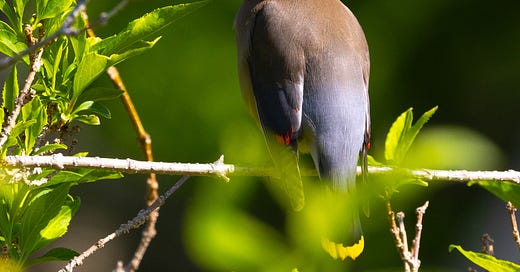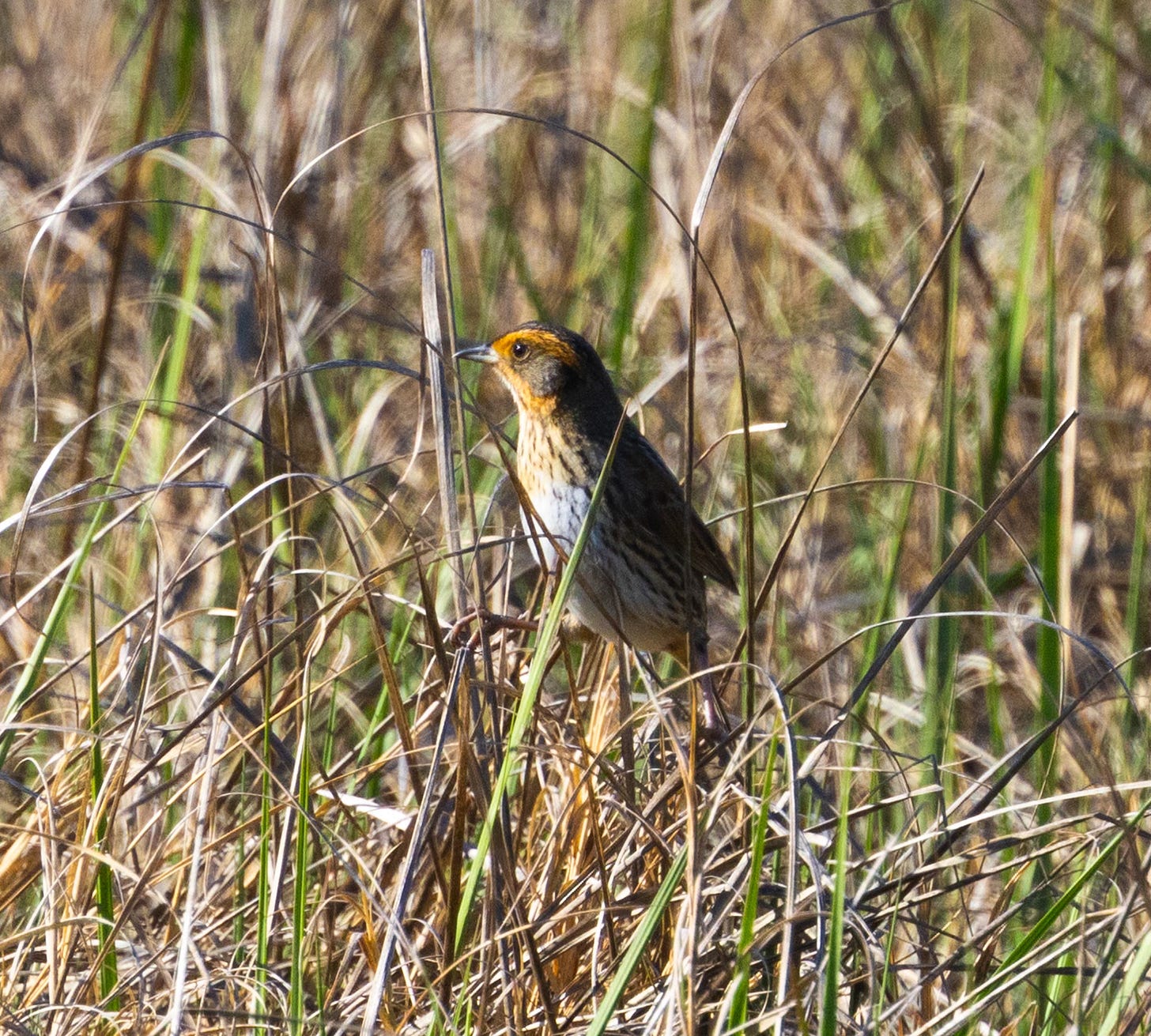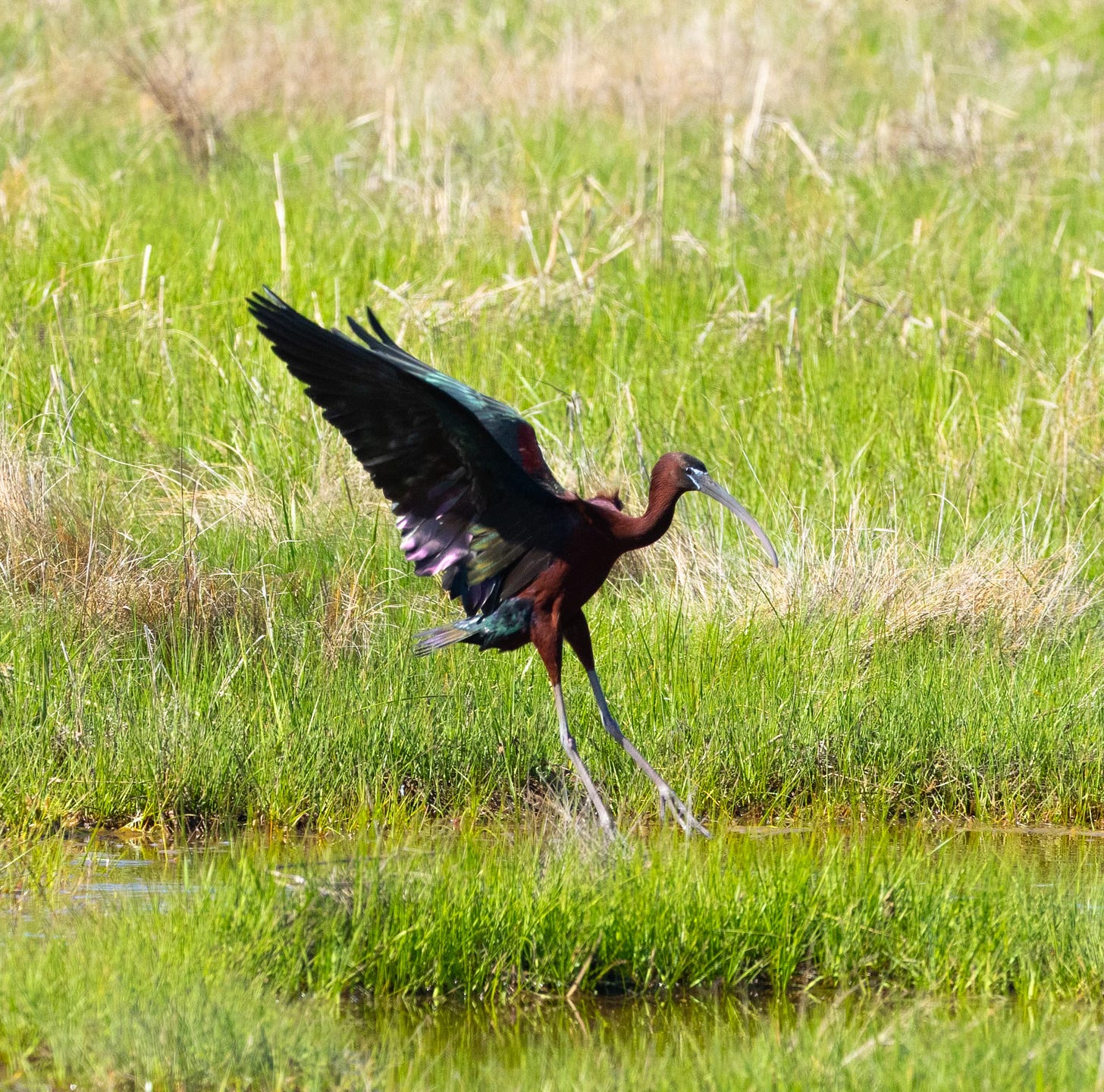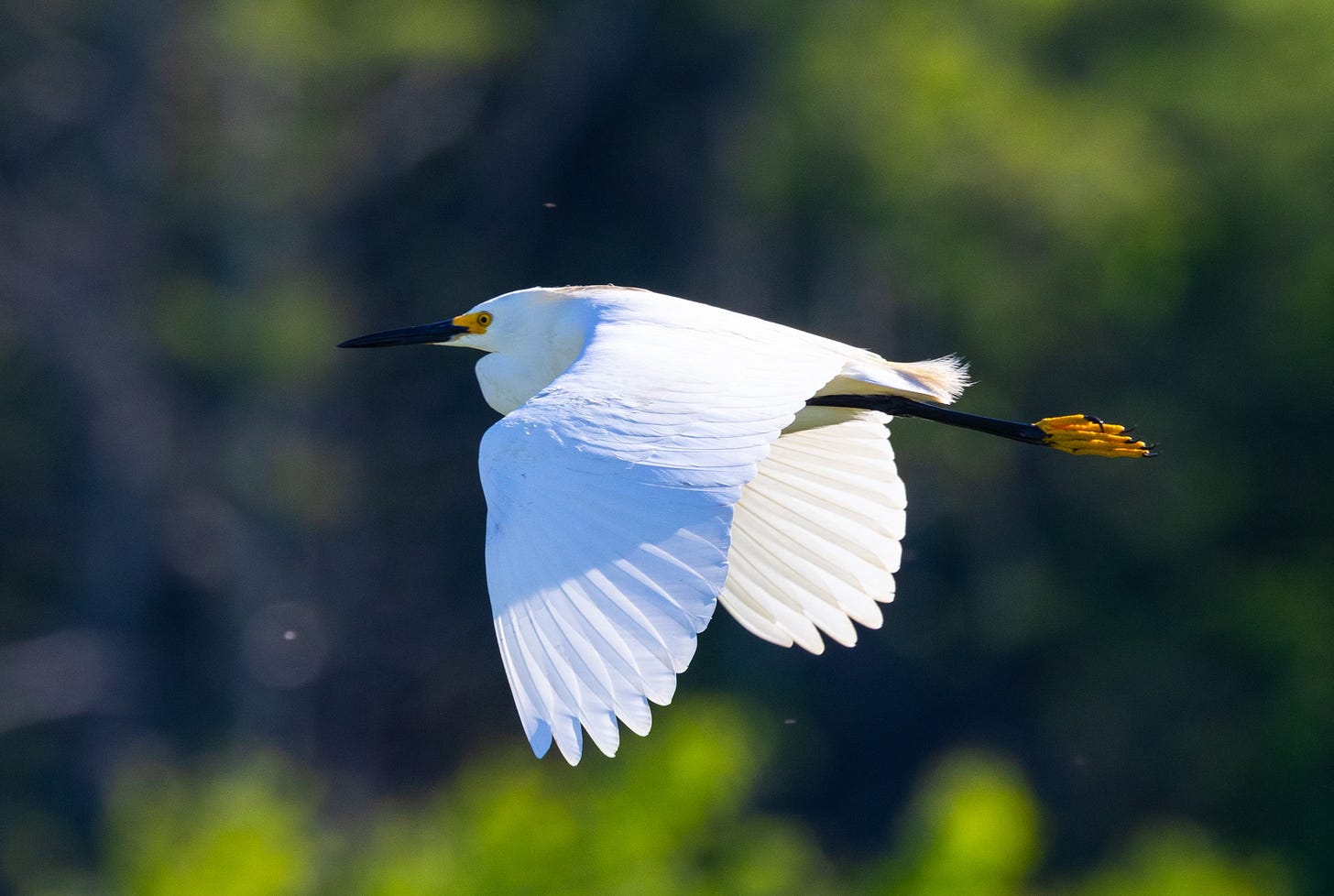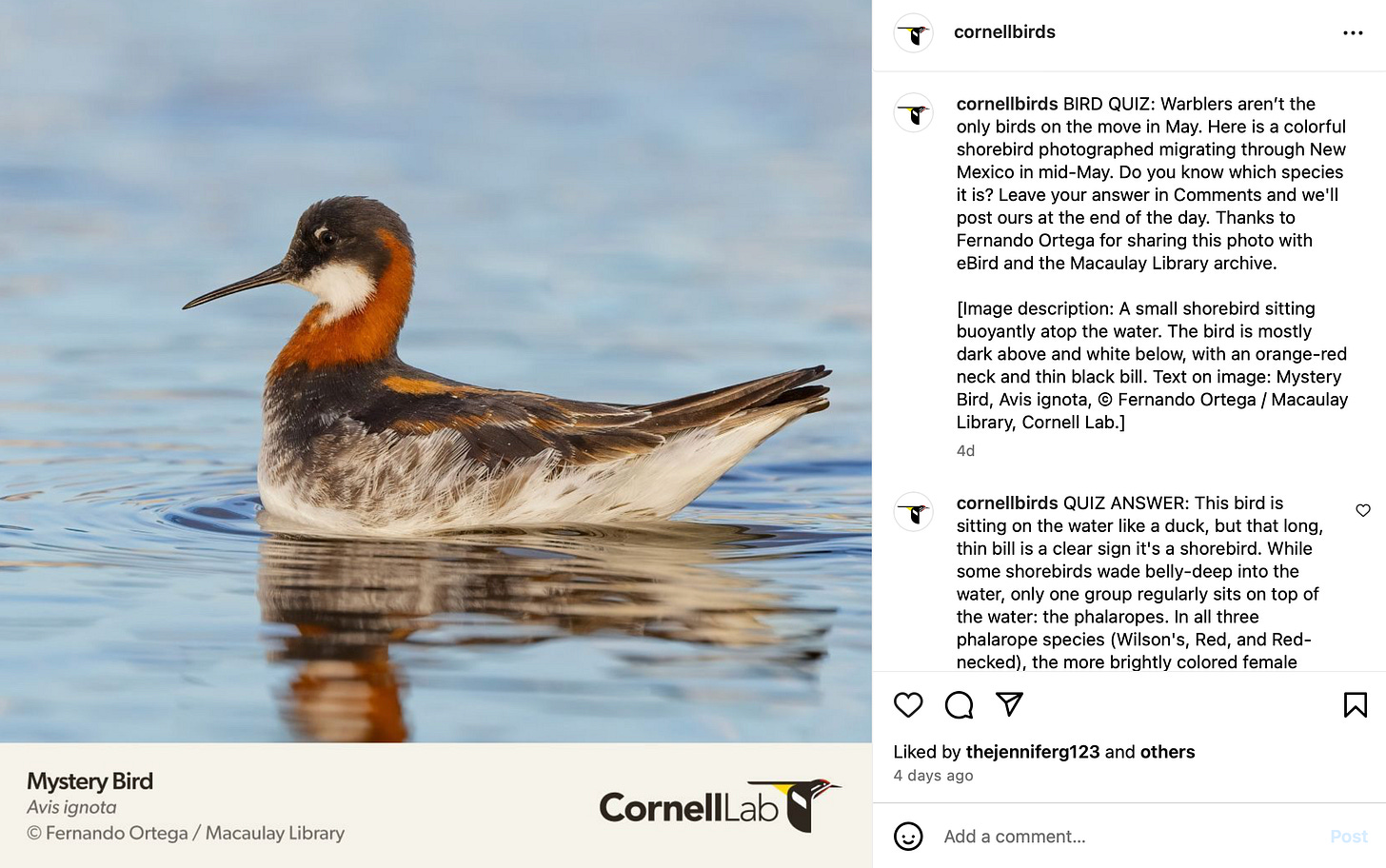1. Let’s start with a wonderful opinion piece by James Gorman, long-time NYT science writer - “Absorb their alien presence”: I saw a couple of crows dining on roadkill the other day as I was driving by and wondered, Does this count as bird-watching? I think it should. I know that birding is having a moment. It was something you could do outside without catching Covid at the height of the pandemic. And it offers the opportunity for being close to nature and spending money on fancy binoculars at the same time, a winning combination for 45 million Americans. I’m not an expert birder. I don’t have a life list, and I can’t tell one juvenile gull from another. But I know never to say sea gull (real birders will have your head). And I don’t just watch the birds that come to the feeder or land on a plate while I’m having lunch at an outdoor table. (via The New York Times)
2. Going pink! - Flamingos taking hold in Florida: in the past nine months, flamingos have appeared throughout Florida in places where they haven’t been seen in decades — sightings scientists hope mark the return of one of the state’s most celebrated symbols. They’ve been photographed while taking a leisurely swim within eyeshot of office buildings in Tampa Bay, hanging out with pelicans near Sanibel Island and sharing a sandspit with great blue herons just a few miles from Kennedy Space Center. Researchers believe the new arrivals blew in with Hurricane Idalia last August, probably from Mexico or the Bahamas, where conservation efforts over the past 50 years have helped flamingo populations recover from near extinction. It wasn’t the first time a powerful storm swept the birds to Florida. But in most of those instances, the flamingos left after only a few days. (via The Washington Post)
By Hap Ellis, Cedar Waxwing - Land’s End, Kennebunkport, ME
3. And just when you thought you had to go to Florida to see flamingos: A few minutes later, all four were standing together surrounded by a pond teeming with wildlife enjoying the morning sun. Like Schmalz, Abby Sterling of Brunswick wasn’t going to miss the chance to see flamingos in her backyard, right here in Glynn County. She is a shorebird biologist who used to work for Little St. Simons Island and now works for Manomet, a bird research and conservation organization. Making the visitors even more special is the knowledge from her time at Little SSI that Myrtle Pond is a managed habitat. “This is a great opportunity to see how a managed habitat can benefit all species, even those that don’t normally make their homes here,” Sterling said. (via The Brunswick News)
4. Birding for the soul: Birding is a hot hobby in the post-pandemic era. It comes with a slew of perks, from boosting mental health to aiding scientific discovery. 96 million Americans — more than 35% of people who are 16+ — have taken part in bird-watching or bird conservation activities, according to a 2022 U.S. Fish and Wildlife Service survey. That's more than double the share in 2016, when the last survey was taken. "Sometimes we internalize this idea of wilderness and nature as being synonymous with grand sweeping vistas like Yellowstone or Yosemite," Ed Yong, Pulitzer-winning science writer and recently converted birder, tells the Axios "1 Big Thing" podcast. "For most of us, those places are hard to get to," he said. "What birding has taught me is that nature is really just around me all the time.” (via Axios)
5. Saving the most trafficked endangered bird species in Brazil: As the door of the wire enclosure is unlatched, a small coal-black bird hops forward. For a moment, it perches at the threshold and cocks its head quizzically at its newfound liberty, then flits into the undergrowth of the surrounding savanna. Within just a few minutes, its mate, a chestnut-brown female, follows suit. These two great-billed seed finches are part of a decades-long conservation project that aims to reintroduce one of Brazil’s most endangered species into a part of the Cerrado grassland that used to be its home before poaching for trade wiped out the birds. (via Mongabay News)
6. Mississippi Kites on the Cape (ed. note…beautiful pic!): Mississippi How birds sing: Have you ever wondered how a bird sings? Or made some of their less melodic vocalizations, like squawks, trills, or chirps? It all happens in the syrinx, a vocal organ unique to birds. In reptiles, amphibians and mammals, including humans, use their larynx to produce sounds. The syrinx varies widely between bird species and there’s still a lot that scientists don’t understand about how it works and its evolutionary history. Better understanding the syrinx of living birds can help scientists get closer to figuring out what dinosaurs sounded like. (No, the dinosaur sounds in “Jurassic Park” are not scientifically accurate.) In a recent Science Firday episode, guest host Arielle Duhaime-Ross talks with Dr. Julia Clarke, professor of vertebrate paleontology at the Jackson School of Geosciences at the University of Texas, Austin, about her recent research studying the syrinxes of ostriches and hummingbirds. (via Science Friday)
By Hap Ellis, Saltmarsh Sparrow - Scarborough Marsh, Scarborough, ME
7. Not a lot of good news from Venezuela but here’s some: Each morning, as Luis Arrieta heads out to begin work on his shade-grown coffee farm, vindication comes in the form of birdsong gushing from the trees, a cacophony of trills and warbles of passerines punctuated by the croaks of the groove-billed toucanet (Aulacorhynchus sulcatus). “It’s one of the rewards of my job,” he says. An agronomist hailing from a family that has grown coffee in Venezuela’s Cordillera de la Costa for generations, Arrieta always had a keen interest in animals, particularly birds. During a stint as the director of the Pinar Zoo, he became involved in a captive breeding program for the endangered red siskin (Spinus cucullatus). After his return to agronomy, the little vermillion red finch would be the muse that inspired the Cafe y Aves (Coffee and Birds) program. (via Daily Coffee News)
8. Celebrating Black Birders Week in Philadelphia: To Sean Stallworth, birding feels almost like watching the closing moments of a sports game. It’s a new feeling for him; Stallworth loves nature but calls himself more of a “bug guy.” When he went out on his first birding trip a few years ago with the Philly-based and Black-led birding group, In Color Birding Club, he was open to watching some beautiful birds, but he didn’t understand why people were so passionate about it. He found out pretty quickly. “Everyone saw a bird, a rare bird, and the intensity of the group, all coming together, everybody was being quiet and it was like, don’t make no noise. It was serious ... it was like the last 30 seconds of the basketball game. It was like the clock is running real fast and every dribble is magnified. It was just like that,” he said. “That excitement, that joy that it brought people out of doing something that they love ... to me, that was everything. I was like, oh, this is different.” (via Philidephia Inquirer)
9. BNI had this study last week, but Nature has a nice take: Certain neurons encode memories of events that occurred in specific physical locations known as place fields. Chickadees show patterns of neuronal activity that are specific to locations of hidden food but independent of place fields. Food caching, or storing food for later consumption, is a crucial behaviour for many animals, including several avian and mammalian species. The black-capped chickadee (Poecile atricapillus, Fig. 1) is an example of a bird that exhibits food-caching behaviours. Other animals steal cached food, so chickadees often return to check but not recover caches, and they will later recover cached food after periods of hours, days or even weeks, suggesting that they have robust mechanisms for encoding and storing memories. (via Nature)
10. Bird flu item - a third person: A third dairy worker in the U.S. has tested positive for the bird flu infection that is causing outbreaks in cattle in at least nine states. The farmworker, from Michigan, was exposed to infected cows and is the first of the three recently confirmed cases to have respiratory symptoms, according to the Michigan Department of Health and Human Services. The previous two people—another in Michigan and one in Texas—did not show any respiratory symptoms but experienced discharge from the eyes. The dairy worker in the latest case worked on a different farm in Michigan than the previous case reported in the state. It's not clear whether the respiratory symptoms indicate that the virus is changing; CDC scientists are conducting additional sequencing studies to determine if that's the case. (via Time)
By Hap Ellis, Glossy Ibis - Scarborough Marsh, Scarborough, ME
11. Birds and storms (sadly, we may be seeing more such “items” this fall): Birds are not necessarily the first thing on most people’s minds when a hurricane is churning toward them. But birders have some unique personalities, and I’ve received more than the occasional text from mainland birder friends wanting to know what I was seeing as the barometer dropped and the wind came up. What birders are looking for in hurricane and tropical storm situations are weird and exotic things from foreign lands. Birds get caught in storms pretty often — usually pelagic birds, which spend their life at sea, but also the occasional migrant just trying to make it from one place to another.Birds living in tropical oceans, such as bridled terns, sooty terns, magnificent frigatebirds and brown noddies, end up in places like New Jersey, Wisconsin and Montana. Sometimes they are pushed by the front of the storm, sometimes they are caught up in it, and sometimes they ride in the eye of the storm. (via Keys Weekly)
12. For landowners who have fields: Landowners can make a difference by altering the times of year they mow fields. Fish and Wildlife is encouraging landowners to help these beloved species by waiting to mow fields used by grassland birds, giving them a chance to rear their young. Bobolinks, Savannah sparrows, eastern meadowlarks and wild turkeys build nests right on the ground, among the grasses and wildflowers. Deer fawns and other animals take refuge in grass fields, and other birds such as bluebirds, kestrels, whip-poor-wills, and northern harriers rely on grass fields for food. According to Renfrew, landowners who do not need to mow for animal forage can accommodate nesting birds by cutting late in the summer, preferably after August 1. (via Vermont Biz)
13. Distressing: Wildlife and environment officials have discovered 10 birds covered in oil on the Oregon and Washington coasts since Sunday. An investigation now spans federal and state agencies, but the oil’s source remains a mystery. Federal agencies are investigating via aircraft and satellite. Birds have been found between Lincoln City, Oregon, and Long Beach, Washington. Agencies recovered four oiled birds alive in Oregon, the Coast Guard said in a news release Wednesday. Responders found two contaminated birds dead and four alive in Washington. Two of the live birds had to be euthanized due to preexisting injuries in conjunction with their contamination, a Washington Department of Fish and Wildlife spokesperson said. All of the birds were common murres, primarily aquatic birds that look similar to penguins. (via Seattle Times)
By Hap Ellis, Snowy Egret - Scarborough Marsh, Scarborough, ME
14. Finally, a look Great Lake birds: Amanda Rodewald is taking us down a path in Sapsucker Woods. It’s a chilly, windy early spring day in Ithaca, New York. In fact, there are a few snowflakes falling along the wooded path. Rodewald is the Senior Director of the Center for Avian Population Studies at the Cornell Lab of Ornithology. “The trends are worrisome. When we look across North America since 1970, we've lost an estimated, almost one third of the breeding populations of birds.” She is the Senior Director of the Center for Avian Population Studies at the Cornell Lab of Ornithology. “To put it in perspective, at least for me, I was born in 1970. So that's just in my lifetime. Almost one out of three individual birds lost,” Rodewald said. That’s an estimated 3 billion fewer birds. This is the first report of three that will look at those challenges. (via Bridge Michigan)
Bird Videos of the Week
Video by PBS, “The Pioneering Teacher Who Became Seattle’s Bird Lady”.
Cornell Live Bird Cam.- #CanaryInYourCoalMine
Cornell Live Bird Cam.- Mystery Bird

